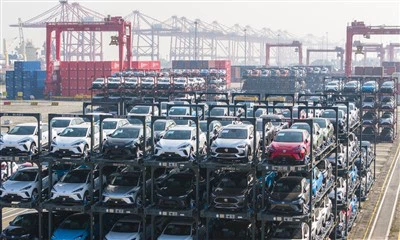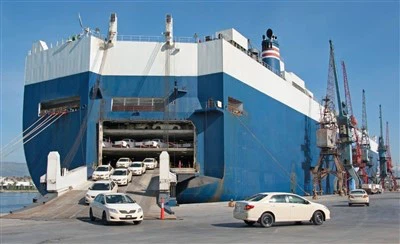South Africa is located at a strategic position where the Indian Ocean and the Atlantic Ocean meet, and it is an important hub for global maritime trade. The coastline of South Africa stretches for 1,739 miles. It handles over 8,800 ships every year, and its port trade volume is approximately 304 billion US dollars, of which 92% of the trade volume is processed through its major ports. As a leading freight forwarder in China[1] , Wilson is well aware of the importance of choosing the right port to meet your freight needs. For this reason, in this article we will explore with you the five busiest ports in South Africa, including an introduction to their infrastructure, cargo handling capacity and their role in global trade, to help you make informed logistics decisions.

South Africa's Trade and Maritime Landscape
South Africa's ports are vital to its economy, serving as gateways for imports and exports to key markets like China, Germany, and the United States. The country is a significant player in global dry bulk shipping, handling about 1.22% of the world's dry bulk cargo vessel calls. Its competitive fuel costs attract long-haul ships for bunkering and transshipment, while its proximity to the Cape of Good Hope enhances its role as a strategic maritime hub. Operated under the oversight of the Transnet National Ports Authority, these ports connect global trade routes, making South Africa the busiest port network in Africa.
How We Evaluate South Africa's Busiest Ports
To identify the top 5 busiest ports in South Africa, we consider several key metrics:
- Annual Cargo Throughput: Measured in metric tons (MT) or twenty-foot equivalent units (TEUs) for containers.
- Vessel Calls: The number of ships docking annually.
- Cargo Specialization: Handling of dry bulk, bulk liquid, containers, or specialized cargo like iron ore and automobiles.
- Infrastructure: Berth numbers, draft depths, and equipment like cranes or conveyors.
- Connectivity: Links to rail, road, and inland logistics networks.
- Global Role: Contribution to international trade routes and hub functions.
These factors ensure a comprehensive assessment of each port's capacity and suitability for various cargo types.

South Africa's Top 5 Busiest Ports
1. Port of Durban
The Port of Durban is the busiest port in Africa, handling 60% of South Africa's container traffic and processing 81.21 million tons of cargo annually. With 3,253 vessel calls per year, it spans 18.5 km² and features 58 berths, including dedicated container, automotive, and multi-purpose terminals. Its infrastructure includes two floating cranes and a ro-ro (roll-on/roll-off) terminal for vehicles. Connected by a 302-km rail network, Durban serves as South Africa's primary container hub, with Pier 2-developed by ICTSI and Transnet-aiming to rival world-class container terminals. Its maximum draft of 15–16 meters accommodates vessels up to 230,000 DWT, making it ideal for diverse cargo, including containers, dry bulk, and bulk liquid.
Why Choose Durban? Perfect for containerized goods, automotive exports, and multi-modal logistics, with robust rail and road connectivity to inland markets.
2. Port of Richards Bay
The Port of Richards Bay leads South Africa in cargo volume, handling 92 million tons annually, predominantly dry bulk like coal, which accounts for 55% of the country's cargo throughput. Designed for large vessels, it supports very large ore carriers (VLOCs) with drafts up to 19.5 meters and lengths of 350 meters. Its six berths, equipped with high-efficiency loading systems (8,500–11,000 MT/hour), are tailored for coal and liquid chemicals. An 80-km rail link ensures seamless transport from inland mines. Richards Bay's specialized infrastructure makes it a cornerstone for South Africa's coal exports, primarily to Asia and Europe.
Why Choose Richards Bay? The go-to port for coal and other dry bulk cargoes, with unmatched loading efficiency and deep-water access.
3. Port of Cape Town
Located at South Africa's southwestern tip, the Port of Cape Town is a key export hub for agricultural products and containerized goods, handling 9.84–11.25 million tons annually and 2,520 vessel calls. Its 34 berths, with a maximum draft of 15.9 meters, include six for containers and specialized facilities like a 28,000 m³ grain silo and a dry dock for ship repairs. Connected by rail, it serves frequent container routes to Europe and the Americas, balancing commercial and tourism functions. Its infrastructure supports diverse cargo, from foodstuffs to general trade goods.
Why Choose Cape Town? Ideal for agricultural exports and containerized trade, especially to European markets, with versatile facilities.
4. Port of Saldanha Bay
The Port of Saldanha Bay is South Africa's premier iron ore export hub, processing 60 million tons annually, primarily for Asian and Middle Eastern markets. Its deep-water port, with drafts up to 23.7 meters, accommodates Cape-size vessels and VLOCs across six berths, including three dedicated to iron ore. A standout feature is the 861-km Sishen-Saldanha railway, directly linking northern Cape mines to the port. Automated conveyor systems enable efficient, crane-free loading during daylight hours, enhancing operational reliability.
Why Choose Saldanha Bay? Optimal for iron ore and other bulk cargoes, with deep drafts and direct rail access to mining regions.
5. Port of Ngqura (Coega)
The Port of Ngqura, also known as Coega, is South Africa's newest and deepest container port, designed for a capacity of 2 million TEUs. Located 20 km from Port Elizabeth, it features seven berths with an 18-meter draft, capable of handling ultra-large container ships (12,500 TEUs). With 1,680 reefer points, it excels in temperature-controlled cargo like fruit and seafood. Spanning 120 km², Ngqura offers expansion potential and complements Port Elizabeth in a dual-port strategy. Its rail connectivity enhances access to inland markets.
Why Choose Ngqura? Best for containerized and refrigerated cargo, with modern facilities and capacity for large vessels.
Other Notable South African Ports
Beyond the top five, two ports play significant roles in specific niches:
- Port Elizabeth: Adjacent to Ngqura, it handles bulk cargoes, liquids, and containers, with a unique capacity for manganese ore (350,000 tons). It complements Ngqura's container focus.
- Port of East London: South Africa's only river port, specializing in RORO Transport (e.g., Mercedes-Benz vehicles) and grain, with advanced safety and monitoring systems.

Infrastructure and Connectivity Overview
|
Port |
Rail Connectivity |
Max Draft |
Berths |
Key Infrastructure |
|
Durban |
✅ |
15–16 m |
58 |
Floating cranes, ro-ro terminal, multi-purpose |
|
Richards Bay |
✅ |
17.5–19.5 m |
6 |
High-speed coal loaders, coal berths |
|
Cape Town |
✅ |
15.9 m |
34 |
Grain silo, dry dock, container berths |
|
Saldanha Bay |
✅ |
23.7 m |
6+ |
Iron ore conveyors, mine-linked railway |
|
Ngqura (Coega) |
✅ |
18 m |
7 |
Reefer points, ultra-large container berths |
Choosing the Right Port for Your Cargo
Selecting the optimal port depends on your cargo type and logistics needs:
- Bulk Minerals (Coal, Iron Ore): Richards Bay and Saldanha Bay offer deep drafts, specialized equipment, and direct rail links to mines.
- Containerized or Refrigerated Goods: Durban and Ngqura provide advanced container terminals and reefer facilities for perishables like fruit or pharmaceuticals.
- Agricultural or General Trade Exports: Cape Town excels in foodstuffs and European-bound containers, with versatile infrastructure.
- Additional Factors: Consider port efficiency, customs clearance, and destination route availability to optimize your supply chain.
FAQ
Q1: Which South African port is best for iron ore exports?
Saldanha Bay, with its 23.7-meter draft, 861-km mine railway, and Cape-size vessel compatibility, is purpose-built for iron ore.
Q2: Can the Port of Durban handle large ships?
Yes, it accommodates vessels up to 230,000 DWT and is South Africa's leading container port by volume.
Q3: Which port is most suitable for cold-chain cargo?
Ngqura (Coega) stands out with 1,680 reefer points and dedicated temperature-controlled facilities for perishables.
Q4: Do these ports offer rail connectivity?
All five major ports are rail-connected, with Saldanha Bay's 861-km iron ore line being the most extensive.
Conclusion
The ports of South Africa are the pillar of its trade economy, connecting the southern African region with the global market. From Durban's container advantages, to Richards Bay's expertise in coal, and to Saldania Bay's strength in iron ore, each port has its unique strengths. Whether you are a freight forwarder, trader or logistics planner, understanding the capabilities of these ports can ensure the efficient transportation of goods.
Zhejiang Wilson Supply Chain Management Co., Ltd. Focus on maritime transportation services between China and South Africa. With rich experience, good relationships with carriers and strategic partnerships with major popular ports, Wilson offers comprehensive full container ocean freight services, covering all major ports in China (including Shanghai, Ningbo, Shenzhen and Guangzhou) to all popular ports in South Africa. Are you ready to deliver the goods? Please contact us to get a cheap quote for sea freight from China to South Africa. ( gm@wilson-cargo.com )







